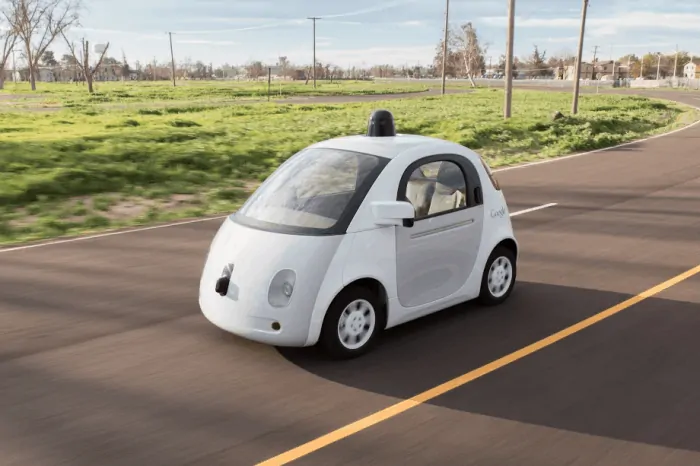Fiat. Anime.
A few words that come to mind when the new Google self-driving car was revealed this week at the company’s HQ in Mountain View.
Also: cartoon.
This is a small — tiny — car. Where is the space for the pull-out bed? Where’s the space to mount a flat-screen? And, what about that mini-fridge? All important considerations, if the dream is to free-up our time, to allow computers to perform the mundane task of driving then surely, a future version of Google’s prototype will be luxury-sized.
According to an update posted today on the Google Blog by Chris Urmson the director of Google’s self-driving car project, the miniaturized cars will hit the streets this summer occupied by Google “safety drivers”, and run the same software used to power the self-driving Lexus RX450h SUV (which I’ve seen frequently in Silicon Valley, most notably up and down Highway 101).

“That fleet has logged nearly a million autonomous miles on the roads since we started the project, and recently has been self-driving about 10,000 miles a week.” According to the post that equates to about 75 years of typical American driving — quite impressive for a nascent technology experiment.
It seems as though this phase of the project will be predominantly focused on neighborhoods, and suburban spaces. Unlike previous cars, this one maxes out at only 25mph, and has a range of 80 miles (comparable to the electric Nissan Leaf). The idea here is to learn “how the community perceives and interacts with the vehicles.”
ON SAFETY
Google is quick to point out that human error accounts for approximately 94% of all crashes, and links to a NHTSA “traffic safety facts” study from February of this year.
So far Google’s driver-less record is commendable. As of this month, of a fleet of 23 cars, only 11 accidents have been logged, and all, from my understanding, due to human error.
PUBLIC AVAILABILITY
2017 is when Sergey Brin says these cars will be available to the general public. Though laudable, that seems like an incredibly aggressive timeline, especially considering the technology involved, bureaucracy of federal and state legislation, and, also, the no-doubt complex negotiations in (or soon to be in) process related to finding a partner to build these autonomous vehicles. For comparison, Tesla was founded in 2003, announced its first internally designed electric car, the Model S, in 2008, and started deliveries four years later. That’s nine years from idea to market. Meanwhile the Model X, an SUV version, has faced several delays — mostly related to scaling production.
BUT WHAT ABOUT THOSE OF WHO ENJOY/LOVE DRIVING?
I love driving. Even in my Prius. There’s nothing quite like, letting loose on my favorite Google Music playlist, letting down the windows, and puttering around Silicon Valley, or up and down Highway 29 in Napa. There’s a zen-ness to the whole thing, an escape from my laptop, and video editing system. Fresh Air with Terry Gross is perhaps the single greatest reasons why cars must continue to have FM radios. How many times have I arrived home, only to wish my commute was… longer, and then to sit in the garage listening to the end of a segment?
Of course, for those of who love to drive, the answer is easy: keep driving. Don’t buy a Google self-driving car. My wife is the polar opposite when it comes to the idea of an autonomous automotive future. Think of all the hours of extra time we could have to do something productive in our lives?! We could read more. Spend more time talking with family and friends, or maybe use the extra time to fire off emails, and (perhaps) reduce the length of our workdays. Or, best of all, get more sleep. I find that last one most interesting (i.e. terrifying). Imagine highways full of driverless cars, with their occupants zonked out, none worse for the wear. I’m not so sure I could do that — I’d be nervously ready to wrestle the wheel in a moment’s notice, not simply because Google might drive my Prius into the back of another Prius, but also because holding onto a steering wheel is hard wired into my very being.
